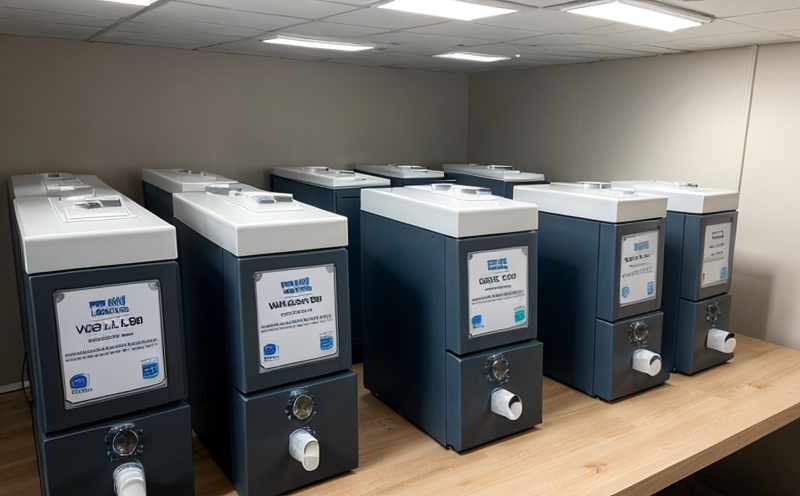EN ISO 12460-3 Wood based panels Formaldehyde release Gas analysis
The EN ISO 12460-3 standard outlines the method for determining formaldehyde release from wood-based panels. This testing is crucial in ensuring compliance with environmental and health regulations, particularly where formaldehyde exposure could be a concern. Formaldehyde is a volatile organic compound (VOC) that can off-gas into indoor environments during the use or processing of wood-based products such as particleboards, medium-density fiberboards, and oriented strand boards.
The test involves placing the specimen in a controlled environment where it is exposed to a flow of air for a specified period. The formaldehyde released from the sample is captured by a suitable absorbent solution and then quantified using gas chromatography or other analytical techniques. This method allows for an accurate determination of the amount of formaldehyde that can be expected to off-gas over time, which is critical for understanding potential health impacts.
Wood-based panels are widely used in construction and furniture manufacturing due to their affordability and versatility. However, excessive levels of formaldehyde can pose significant health risks, including irritation of the eyes, nose, and throat, as well as more severe conditions like cancer. Therefore, ensuring that products meet regulatory limits is essential for both consumer safety and market compliance.
The test procedure is meticulously detailed in EN ISO 12460-3 to ensure consistent results across different laboratories. Specimens are prepared according to the standard’s specifications, which may vary depending on the type of wood-based panel being tested. For instance, particleboards require specific cutting dimensions and surface treatments to accurately reflect their formaldehyde release characteristics.
The test apparatus typically includes a climate chamber for maintaining controlled temperature and humidity conditions during the exposure period. Gas chromatography is often used for quantifying the captured formaldehyde, but alternative methods such as titrimetric analysis or headspace gas chromatography can also be employed. The acceptance criteria stipulated in EN ISO 12460-3 ensure that results are reliable and reproducible.
Understanding the formaldehyde release from wood-based panels is not only important for ensuring compliance with standards but also for enhancing product quality and safety. By accurately measuring the amount of formaldehyde released, manufacturers can optimize production processes to minimize environmental impact while maintaining product integrity.
In conclusion, EN ISO 12460-3 provides a robust framework for assessing formaldehyde release from wood-based panels, offering valuable insights into both health risks and regulatory compliance. This testing is particularly relevant in sectors such as construction, furniture manufacturing, and home furnishings where the potential exposure to formaldehyde is significant.
Eurolab Advantages
At Eurolab, we pride ourselves on offering comprehensive and accurate testing services for wood-based panels, including formaldehyde release gas analysis. Our expertise in this area ensures that our clients receive reliable results every time. Here are some of the key advantages:
- State-of-the-art Equipment: We utilize cutting-edge analytical instruments to ensure precise measurements and consistent results.
- Certified Technicians: Our team is composed of highly skilled professionals who are well-versed in EN ISO 12460-3 testing methodologies.
- Comprehensive Reporting: We provide detailed reports that offer a comprehensive overview of the test results, including any necessary recommendations for improvement or compliance.
- Quick Turnaround Times: Our efficient processes allow us to deliver results in a timely manner, minimizing disruptions to your operations.
- Compliance Expertise: We stay updated with the latest regulatory changes and ensure that our testing aligns with all relevant standards.
- Confidentiality: Your data remains strictly confidential, ensuring that sensitive information is protected throughout the testing process.
By choosing Eurolab for your formaldehyde release gas analysis needs, you can be confident in receiving high-quality, reliable results that meet all necessary standards and guidelines.
Why Choose This Test
- Health and Safety: Ensuring compliance with formaldehyde release limits is crucial for protecting consumer health and safety.
- Regulatory Compliance: Meeting the stringent requirements of EN ISO 12460-3 helps avoid legal issues and ensures market access.
- Product Quality: Accurate testing provides insights into product performance, allowing for continuous quality improvement.
- Risk Management: Identifying potential risks early can help mitigate environmental impacts and improve overall sustainability practices.
- Customer Satisfaction: Demonstrating a commitment to safety and compliance enhances customer trust and satisfaction.
- Innovation: Understanding formaldehyde release characteristics can drive product innovation and development.
Selecting this test ensures that you are taking proactive steps towards maintaining high standards of quality, health, and environmental responsibility. It is an essential step in the lifecycle of wood-based products, from production to end-use.
Competitive Advantage and Market Impact
The ability to accurately measure formaldehyde release from wood-based panels provides significant competitive advantages. Consumers increasingly demand eco-friendly and health-conscious products, making it essential for manufacturers to demonstrate compliance with formaldehyde standards.
- Enhanced Reputation: A reputation for delivering safe and compliant products can significantly enhance your brand's image in the market.
- Better Market Access: Compliance with international standards like EN ISO 12460-3 opens doors to global markets, particularly those with stringent environmental regulations.
- Increased Sales: Meeting regulatory requirements can lead to increased sales as consumers are more likely to choose products they trust are safe and environmentally responsible.
- Differentiation in the Market: Providing customers with detailed formaldehyde release reports can differentiate your product from competitors, offering a unique selling point.
- Cost Savings: Early identification of potential issues through accurate testing can prevent costly recalls or legal actions down the line.
- Innovation Opportunities: Understanding formaldehyde release characteristics can inspire new product innovations and improvements in production processes.
The market impact of this test is profound, as it aligns with growing consumer awareness and demand for safer products. By adopting EN ISO 12460-3 testing practices, you not only meet current regulatory requirements but also position your company at the forefront of sustainability and quality assurance.





